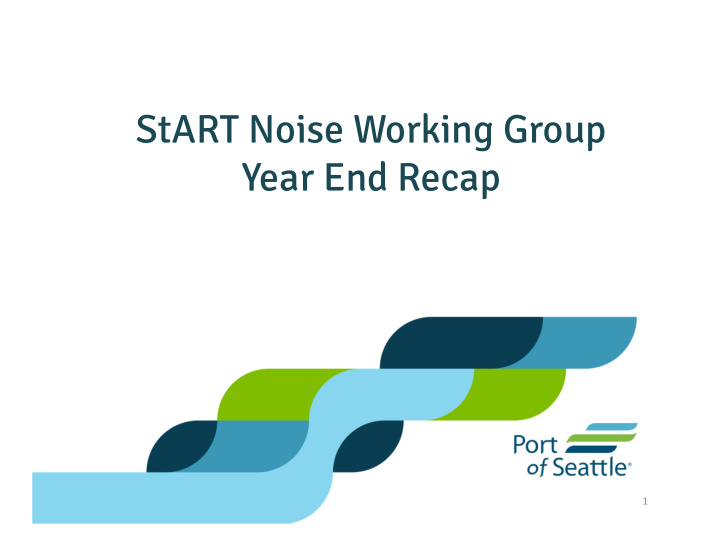



StART Noise Working Group Year End Recap 1
StART Noise Working Group • Formed to work on achievable noise reduction efforts 2
Noise Working Group Members • Terry Plumb • Tom Fagerstrom • Chris Hall • Robert Tykoski • John Resing • Tim Toerber • Earnest Thompson • Steve Ostredahl • Mark Hoppen • Marco Milanese • Eric Zimmerman • Scott Ingham • Robert Akhtar • Tony Gonchar • Joe Scorcio • Randy Fiertz • Ken Rogers • Yarden Weidenfeld • Jason Ritchie • Scott Kennedy 3
Near Term Aviation Noise Action Agenda • Runway Use Agreement • Fly Quiet Voluntary Late Night Noise Limitation Program • Glide Slope Analysis • Ground Noise Analysis • A320 Arrival Noise Retrofit 4
Runway Use Agreement • Revise / update the previous Runway Use Plan. • Purpose of the plan is to establish a clear understanding of the preferred way in which all of the runways will be used in various operating conditions. 5
Sea-Tac Runways 1 1 1 6 6 6 R C L 3 4 3 L 4 C 3 4 R
Runway Use Daytime and Evening Hours • The third runway (16R/34L) will be used primarily as an arrival runway. • The east runway (16L/34R) and center runway (16C/34C) will be used as arrival and departure runways. 7
Runway Use Late Night Usage • During regular late night operations between the hours of 12:00 a.m. and 5:00 a.m. in normal weather patterns, the FAA plans to reduce its use of the third runway (16R/34L). • Departures and/or arrivals will use 16L/34R and 16C/34C • 16R/34L will only be used when required for safety or efficiency reasons. 8
North Flow Preferential Use Nighttime Hours • This implements a preferential runway system during the nighttime hours, for operations through the North Flow Noise Abatement Corridor. This would be operational when traffic and other conditions permit as determined by the FAA. • When conditions permit, during nighttime hours from 10 p.m. to 6 a.m., departures can be shifted from south to north, thus utilizing the established noise abatement corridor over the Duwamish industrial area and Elliott Bay. • This measure was approved by the FAA as Sea-Tac FAR Part 150 Noise Compatibility Program Measure A-11. 9
Fly Quiet Late Night Noise Limitation Program • 12am to 5am • Voluntary measure to reduce late night noise through incentivizing air carriers to fly at less sensitive hours or transition to quieter fleet 10
Why not call it a voluntary curfew? • The program doesn’t change, only the name to better align with the intended outcomes • Curfews are assumed to be “mandatory” 11
Fly Quiet Late Night Noise Limitation Program • 12am to 5am • Utilize the Fly Quiet Program to add additional category • Aircraft flying above an average single event noise threshold will receive a Fly Quiet Program penalty score • Based on 4 nearby noise monitors 12
Site 19 Departure Noise Comparison Average Departure SEL at Site 19, dB, August 2018 75 80 85 90 95 100 B744 B748 B77W A332 A333 B772 MD11 DC10 B763 B77L B739 A321 B738 B753 B752 B789 Note: Not all of B762 these aircraft E75S currently operate at A319 A320 night. B737 Example only. Noise B788 limits will need A359 further evaluation E75L A306 before final. B712
SITE 12 Arrival Noise Example MEASURED AVERAGE SEL 75 80 85 90 MD11 B744 B748 DC10 B77W B772 B77L A306 A333 B763 B762 A332 B753 B789 A359 B788 B739 B738 B752 A319 A320 Note: B737 E75S Example only. Noise A321 limits will need E75L further evaluation C208 DH8D before final.
Fly Quiet Scoring • Compliance with Noise Abatement Corridors • Noise score based on all hours • Compliance with nighttime engine testing rules and regulations • NEW – penalty for late night flights that exceed the noise limit thresholds 15
Monitoring and Reporting • Monthly monitoring of all flights • Reporting to the FAA • Compliance letters to airlines exceeding the late night noise thresholds • Publication of reports, letters and information on the web • Reporting to StART 16
Late Night Noise Limitation Program Additional Efforts • Encouraging airlines to replace noisier aircraft with quieter aircraft • Encouraging all airlines to consider rescheduling of late night flights 17
Glide Slope Analysis • Raising Runway 34R’s Glideslope to lessen aircraft approach noise • Currently at 2.75 degrees • Options to raise it to 3 degrees or 3.1 degrees 18
Ground Noise Analysis • Analyzing airfield ground noise sources to reduce impacts – Taxiing Aircraft – Thrust Reverse – Other • On work plan for 2019 19
A320 Whistle Noise on Approach • Noise occurs between 7 to 30 miles from landing • Caused by a circular vent hole under the wing (similar to blowing over a bottle) • Includes A320, A319 and A321 Aircraft 20
Solution Aircraft must be taken out of “Vortex Generator” service and fuel tanks & 5mm device mounted systems drained of all fuel upstream of the hole before retrofit. Airlines that are completing the fix are typically doing it during downtime with other major maintenance. Device is factory installed on newer A320s Post 2014
A320 Retrofit • Find ways to encourage airlines to complete the retrofit – Discuss with airline staff – Send letters to airlines requesting timeline for implementation 22
Recommend
More recommend